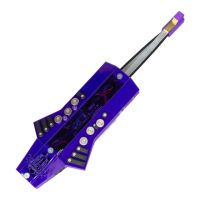vibrato lever. This also sends pitch bend control to your synthesizer, but in a
manner focused on vibrato. The lever senses position change. A forward
movement triggers a slight pitch bend down followed by a return to zero when
the movement stops. The movement back will then trigger a slight pitch bend
up, followed by return to zero when movement stops. This creates a very violin
like vibrato in a way that will feel natural to the player. A slight shaking hand
motion back and forth with your thumb kept on the lever will produce this.
Left hand controls octaves and the fourth valve (perfect fifth, -5 semitones).
Octaves are controlled using the thumb rollers. Let your thumb rest between
two rollers. Rotate your hand while holding the canister and let your thumb
move along the arc of rollers to change octaves. Octaves go from -3 (thumb left
of leftmost roller, not touching it), to -2 (touching only the leftmost roller), -1
(between the first two rollers) and all the way up to +3 (between the two last
rollers). Your index finger controls the fourth valve (-5 semitones).
On the NuRAD there is a similar, but slightly different setup. Topside, there
are three main keys, three pinky keys, a side key and a ”special key” (consisting
of two keys to be touched simultaneously to activate) for chord and interval
functions. On the bottom there are two pitch bend pads and a lever like on the
NuEVI, but for NuRAD it can be useful to have the lever control portamento
instead of vibrato.
Left hand top controls are three main keys, a bis key, two standard pinky
keys, one configurable pinky key and a configurable side key called the mod
key. Octaves are controlled using the thumb rollers on the bottom side. Let your
thumb rest between two rollers. Swipe your thumb up and down over the
rollers to change octaves.

